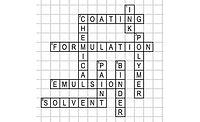Biocides: A Necessary Addition to Any Coatings Formulation
In products such as aqueous coatings, polymers, slurries, adhesives, latex and resin emulsions, sizing, caulk and process waters, biocidal preservatives prevent microbial growth that could lead to product spoilage and contamination.
Green mold and algae that proliferates across surfaces is a familiar signal of decaying product. But along with this visible growth, gas formation, loss of viscosity, poor stability and foul odors could all be results of improperly treated formulations. And, if neglected, these problems could lead to costly customer quality issues, product recall and down time.
Most importantly, bacterial growth can be very damaging to human health. When inhaled, mold and mildew contributes to a decrease in indoor air quality and can be a toxic addition to any workplace.
Protecting Coatings
Coatings are highly susceptible to microbial contamination due to their composition and production. In all stages of their lives, from manufacture to storage to service life, coatings are vulnerable to contamination introduced from a variety of internal and external sources. Raw materials, containers and their closures, manufacturing equipment, the plant environment, and the user or environment can all introduce harmful bacterium.As a result of certain factors associated with their manufacture and storage, some products are particularly vulnerable to attack. Paints, for instance, are especially susceptible to air and waterborne microbial contaminants. This is due to their exposure to bulk storage and handling systems. Similarly, formulations based on latexes all contain organic material suspended in water - a perfect breeding ground for harmful microorganisms.
With the addition of a biocide to your formulation, you are safeguarding your product from the attack of thousands of aggressive microorganism strains that feed on waterborne or other biologically active material. Like in other household and industrial products, preservatives prevent bacteria, fungi, algae, yeast, mold and mildew from eroding away a product's proprietary qualities. Specifically for coatings, biocides are highly effective against gram-negative and gram-positive bacteria, cyanobacteria, yeast, chlorophyceae, enterobacteria and fungi.
Biocides are particularly effective when used proactively in a formulation; however they can also be used for quick clean up of contaminated wash water or other finished formulations.
Neglecting to properly formulate coatings with preservatives and antifungal agents increases your chance of encountering product spoilage and industrial health hazards. Some companies have been faced with millions of dollars in claims when their products grew mildew and algae due to improper biocidal use. No company should take that risk, especially when the solution can be integrated early in the formulation process.
Solutions
Dow Biocides is an industry leader in providing solutions for the coatings market. Boasting a large and diverse product portfolio, Dow can be a one-stop shop for all biocide needs. Since formulation chemists are not necessarily trained to be biologists, a wide range of solutions is available to assist customers in selecting the appropriate biocide to achieve the most value-added results. With regulatory expertise in a rapidly changing legislative landscape, knowledge of chemical compatibility, expertise in risk management and registration support, the company is equipped to help coatings manufacturers design formulations that will meet their individual needs.With superior laboratory capabilities, including TAUNOVATESM high-performance testing capabilities, an advanced testing methodology that provides a quick, accurate and cost-effective analysis of formulation challenges and biocide performance, Dow helps customers minimize costs while achieving optimal performance. Specifically for coatings, the time-kill test can help companies establish the optimum concentration of antimicrobial agent required for their specific formulation.
To support Dow's understanding of how to select the most appropriate biocide, the company is equipped with a wide range of product offerings for this market and can meet the technical and industrial requirements for industrial hygiene, in-can preservation and dry-film preservation. These products include:
Most recently, the product portfolio has been expanded with the addition of benzisothiazolin (BIT), one of the most widely used biocides for in-can preservation. With its high pH stability and low-VOC profile, CANGUARD™ BIT is particularly effective in high-pH systems and where longer-term efficacy is required. BIT is sometimes utilized in blends and gives Dow a new platform to use its combined microbiology and chemistry knowledge for development of tailored formulations and combinations.
Conclusion
Biocides are a necessary addition to coatings formulations, as these products are continuously vulnerable to attack from harmful microorganisms. Historically, Dow has been an industry leader in pairing its quality biocides with knowledge of chemical compatibility and regulatory expertise. The addition of CANGUARD™ BIT Preservatives will ensure that Dow remains a one-stop-shop for all biocides needs.Looking for a reprint of this article?
From high-res PDFs to custom plaques, order your copy today!





